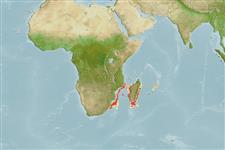Пластиножаберные (акулы и скаты) (sharks and rays) >
Rajiformes (Skates and rays) >
Anacanthobatidae (Smooth skates)
Etymology: Indobatis: Name refers to the distribution of the genus in the western Indian Ocean (Greek 'Indos' for India, 'batis' for skate or ray).
Eponymy: This is an acronym for the Oceanographic Research Institute (ORI) of South Africa, honoured for its contributions to the ichthyology of South African waters. Its research vessel David Davies collected the type of the whiptail. (Ref. 128868), visit book page.
Environment: milieu / climate zone / пределы глубины / distribution range
экология
морской батидемерсальный; пределы глубины 1000 - 1725 m (Ref. 5578). Deep-water; 15°S - 30°S
Western Indian Ocean: off off Mozambique and Madagascar.
Size / Вес / Возраст
половая зрелость: Lm ? range ? - ? cm
Max length : 42.9 cm TL самец/пол неопределен; (Ref. 95335)
Краткое описание
определительные ключи | морфология | морфометрия
This medium sized species grows to about 42.9 cm TL and has the following set of diagnostic characters: disc 0.9-1.1 times as wide as long and with rounded outer corners, it is extremely depressed pear-shaped to broadly inverse heart-shaped (in adult male); snout angle 85-106° and larger in juveniles; snout terminally expanded as a rostral lobe that is 9-12% of preorbital snout length; further juveniles with a short, thin rostral filament; narrow interorbital distance, 2-3% of TL; inner margin of posterior pelvic lobe fused along its entire length to root of tail; length of tail from mid-vent about equal to body length from tip of rostral lobe to mid-vent in adults, but 1.5 times body length in juveniles; surface of upper and lower disc and tail entirely naked except for 2 longitudinal rows of alar thorns in adult male; the tail with 2 lateral rows of fleshy, tubular papillae; colour of upper and lower surfaces dark grayish-brown, but ventral surface somewhat darker; upper jaw with 18=26 tooth rows; monospondylous vertebral centra 25-29; scapulocoracoid subrectangular, the rear corner sharply marked; large oval anterior fenestra no anterior bridge, one very large oval postdorsal and 5 minute to small postventral fenestrae; pelvic girdle with massive ischiopubic bar with straight to weakly concave anterior and deeply concave posterior contour; prepelvic processes are very long and inclined outwards, their length from axis of pelvic girdle maximal width 3.9-5.3 times median thickness of ischiopubic bar (Ref. 95335).
Body shape (shape guide): other; Cross section: flattened.
Found on the slope (Ref. 5578). Oviparous. Distinct pairing with embrace. Young may tend to follow large objects, such as their mother (Ref. 205). Eggs are oblong capsules with stiff pointed horns at the corners deposited in sandy or muddy flats (Ref. 205). Egg capsule measures 36.0 mm long and 19.0 mm wide (Ref. 41249). Taken only by deep-trawling research vessels (Ref. 5578).
Life cycle and mating behavior
половая зрелость | размножение | нерест | икра | Fecundity | личинки
Oviparous. Distinct pairing with embrace. Young may tend to follow large objects, such as their mother (Ref. 205).
McEachran, J.D. and K.A. Dunn, 1998. Phylogenetic analysis of skates, a morphologically conservative clade of elasmobranchs (Chondrichthyes: Rajidae). Copeia 1998(2):271-290. (Ref. 27314)
Статус Красного Списка МСОП (Ref. 130435: Version 2025-1)
Угроза для людей
Harmless
Использование человеком
рыболовство: интереса не представляет
дополнительная информация
инструменты
Специальные отчеты
Скачать в формате XML
ресурсы в Интернет
Estimates based on models
Preferred temperature (ссылка
123201): 3.9 - 5.6, mean 4.7 °C (based on 16 cells).
Phylogenetic diversity index (ссылка
82804): PD
50 = 1.0000 [Uniqueness, from 0.5 = low to 2.0 = high].
Bayesian length-weight: a=0.01000 (0.00244 - 0.04107), b=3.04 (2.81 - 3.27), in cm total length, based on all LWR estimates for this body shape (Ref.
93245).
Trophic level (ссылка
69278): 3.7 ±0.6 se; based on size and trophs of closest relatives
устойчивость к внешним воздействиям (ссылка
120179): низкий, минимальное время удвоения популяции 4.5-14 лет (Assuming fecundity<100).
Fishing Vulnerability (Ref.
59153): Low to moderate vulnerability (33 of 100).
🛈
